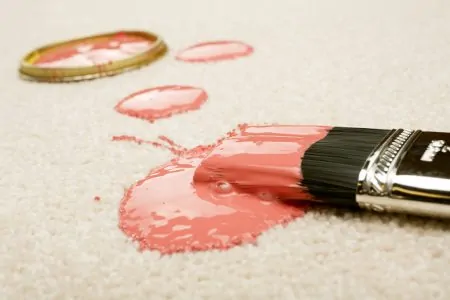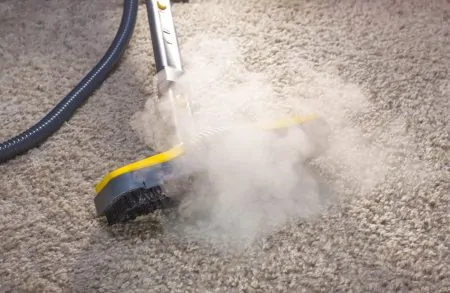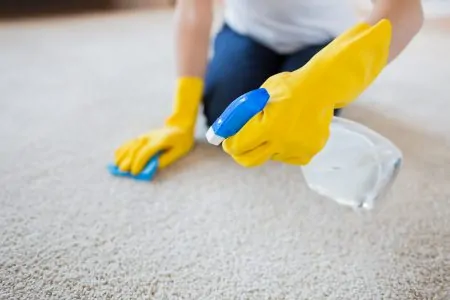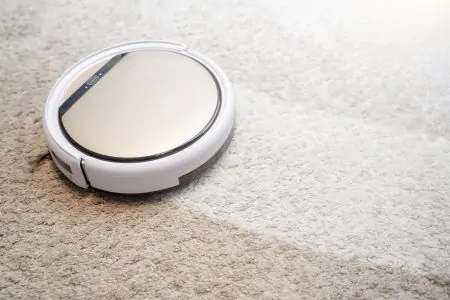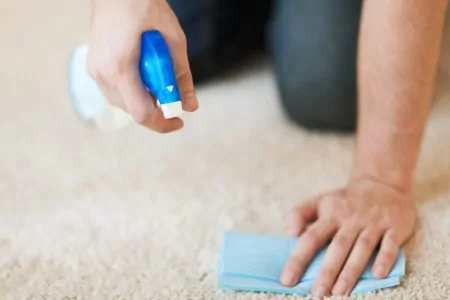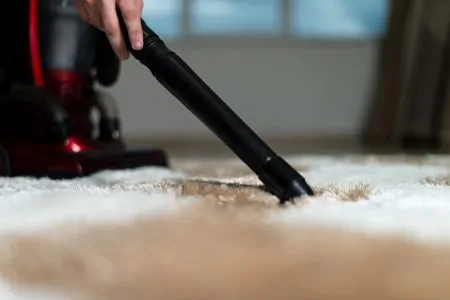Giving your walls a fresh coat of paint will not only freshen up the room, but it can enhance your mood. However, getting a slob of color on your carpet is a real mood killer.
Before you think of replacing it, let us show you how to clean paint out of your carpet. It may sound like a challenge, but you can remove even dry color. So let’s get started.
Key Takeaways
- Identify the type of paint (acrylic, water, latex, or oil-based) and use appropriate cleaning methods.
- For water or latex-based paint, blot with a towel, use a detergent solution, and vacuum the area.
- To remove acrylic paint, dampen the spot, use laundry detergent, acetone, and a commercial carpet cleaner.
- For oil-based paint, scrape the spill, blot the spot, use turpentine, and rinse the area with a detergent solution.
Know Your Paint
Before we get into the how-to’s, you must know what you’re fighting against. Different types of paints require various cleaning products. So for the best results, take a look at the paint container you were using.
Common types used in homes include acrylic, water, latex, and oil-based paints. Once you’ve identified the culprit, follow the specific directions below.
Always Be Cautious
Removing Water or Latex Based Paint
These paints are generally the easiest to remove from any surface, as they’re less oily or tenacious than others. Still, immediate action is the key to the best results.
- Time: 25 minutes
- Difficulty: Easy
What You’ll Need
- An old towel
- Dishwashing detergent
- Water
- Bowl
- Spoon
- White cloth or rag
- Knife or scraper
- A vacuum (wet vac preferred)
- Carpet steamer (optional)
1. Blot With a Towel
As soon as the paint touches the carpet, grab an old towel and begin to blot the spot. Use a cloth you’re willing to throw in the trash afterward. Dab the paint firmly, and the towel should absorb most of it.
Avoid scrubbing the spot as this can cause the paint to dig deeper into the carpet fibers and become impossible to get out.
2. Use a Solution
Grab the dishwashing detergent. Then mix one tablespoon of the soap with one cup of lukewarm water. Soak a white rag with the solution and begin to blot the paint.
When blotting, begin from the outside and work your way toward the middle. Be gentle to avoid digging the spill deeper into the fibers.
If there’s a lot to clean up, use a knife or other scraper to gently draw away the paint. Add more solution as needed. If there are some dry bits, let them soak with the detergent mixture for about five minutes before you continue scraping.
3. Vacuum the Area
Once you’ve finished dabbing the solution, use a vacuum to remove dislodged pieces as well as the fluids. This is a crucial step to avoid mildew and mold from the liquids. We recommend using a wet-dry vacuum for this job.
Repeat the whole process if necessary. You may also use a carpet steamer as these are more effective at removing paint.
Getting Rid of Acrylic Paint Spills
Removing acrylic paint from carpet fibers requires a fair amount of elbow grease and determination. It can be very tenacious, so follow our method strictly.
- Time: 30 minutes
- Difficulty: Easy/Intermediate
What You’ll Need
- Old rags
- Laundry detergent
- A mask
- Gloves
- Acetone, or nail polish remover containing acetone
- An old toothbrush
- Commercial carpet cleaner solution
- A wet vacuum
1. Dampen the Spot
The best way to start is to dampen the spot. Use an old rag, moisten it with clean water, and blot the spill.
2. Add Laundry Detergent
Once you’ve dampened the spot, add approximately one tablespoon of laundry detergent directly onto your rag. Avoid using more than a tablespoon — otherwise, you’d have to wash your whole carpet. Then blot the spot until you see the paint loosening up.
Don’t worry if the paint isn’t disappearing entirely. This is simply to loosen it up to aid in the following steps.
3. Use Acetone
Acetone might be your best weapon against this unsightly stain. Add a small amount to your rag, just enough to moisten it.
Then dab the paint until it begins to lift away. Continue until the stain is gone — add more acetone to your rag if necessary.
Watch Out
4. Scrub With a Commercial Carpet Cleaner
If acetone fails to remove all of the paint, you can use a commercial carpet cleaner as the next step. However, try your best to rinse out the acetone before applying the cleaner.
You can also opt for a professional solution instead of acetone. These will likely get the job done in no time. Find a carpet cleaner that works best for you, but do a patch test before.
Directions vary between brands, but most will tell you to apply an amount of the solution directly onto the spot. Then use an old toothbrush to scrub the area lightly. After cleaning, let the solution work for five to six minutes before rinsing with water.
5. Vacuum the Remains
If you’ve used a good carpet cleaner, the chances are that it absorbed most of the paint. Now, all there’s left for you to do is vacuum it up.
It’s best to use a wet vacuum for the job. Your carpet now contains a lot of liquids, which can ruin your machine if it doesn’t have a waterproof interior. If you don’t own a wet vacuum, shops such as Home Depot rent them out.
Repeat
Cleaning up Oil Paint
Oil paint is straightforward to remove with a tool when fresh, so you must act quickly.
- Time: 40 minutes
- Difficulty: Intermediate
What You’ll Need
- Putty knife
- Small container or bowl
- Clean white cloth or rags
- Gloves
- Turpentine
- Dishwashing detergent
1. Scrape the Spill
Grab your putty knife and insert it under the spill to lift away gently.
Once away from the carpet, place the paint in a container or bowl. Don’t scrub or stab with the putty knife — this could make the stain worse.
If you can’t insert the knife underneath, the paint is likely too dry. In such a case, use a carpet steamer on the area to soften the paint. You can place a rag over the spot to protect your machine.
2. Blot the Spot
Get a clean white rag or cloth, and use it to gently but firmly blot the spot. Continue until you feel that it isn’t absorbing more. If the carpet is still wet, continue with a fresh one.
3. Add Turpentine
To help separate the oil paint from the carpet, add a small amount of turpentine to the cloth. Put some glasses and gloves on and follow the same dabbing motion across the spot without scrubbing. Most of the paint should begin to loosen — continue until all the spill is gone (2).
4. Rinse the Area
After the paint is gone, it’s essential to rinse the spot where you used turpentine to prevent discoloration. Make a mixture of one tablespoon of dishwashing detergent with two cups of cold water.
Take a new, clean cloth and submerge into the solution. Then proceed to moisten the area of the spill. Continue until it’s clean, and no paint color remains.
Grab some paper towels and blot the area to absorb leftover liquids. You can also use a wet vacuum if you prefer.
How to Remove Dry Paint from Carpet
Removing dry paint isn’t impossible unless it’s oil-based, then it can be a challenge. For oil paints, try a carpet steamer and then let it soak for five minutes in a solution of warm water and dishwashing detergent. If it doesn’t come out, you may have to trim the area by cutting the paint loose.
However, for water, latex or acrylic based paints, use the steps below:
1. Scrape off as Much as Possible
Use a knife or putty knife to scrape off as much debris as possible. Then use needle-nose pliers to loosen or remove big spots.
2. Soak and Vacuum
Pour a small amount of warm water over the dry paint and let it sit for five minutes to soften. Then use a wet vacuum to remove as much as possible — repeat this step until most of the paint is gone.
3. Make a Detergent Solution
In a spray bottle, mix half a teaspoon of dishwashing detergent or vinegar with four cups of water. Then spray the spot liberally.
Grab a stiff brush and scrub the spill. Continue until the paint is gone — add more spray if necessary. Once finished, use a wet vacuum to remove excess liquids.
FAQs
Missed a Spot
As a devoted DIY people, we’ve spilled our fair share of paint onto carpets. Knowing how to clean paint out of your carpet helps you respond quicker, which, in turn, increases your chance for success.
First, you must recognize what type of paint it is. Most are either acrylic, latex, water or oil-based. Follow the specific steps for your paint, and remember never to scrub — doing so will spread the spill, causing a bigger problem.
If the paint had time to dry, use a putty knife to separate it from the carpet fibers. Then soak it with a solution before scrubbing. As a last resort, you may have to trim the area — if you do it right, it shouldn’t be noticeable.
